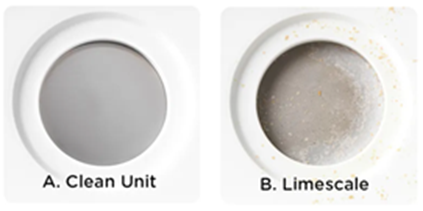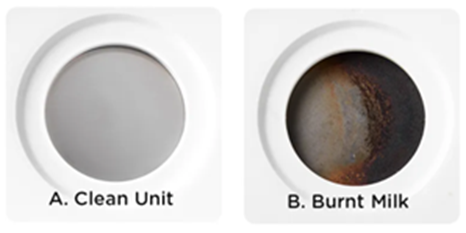Stuck on how to use one of our products?
Not sure how to clean them?
Find all the useful support information right here.

It’s great to see that you’ve purchased a Tommee Tippee Super-Steam Electric Steriliser.
To help you get started and to keep it working effectively, we’ve added all the guidance you should need, plus some handy hint, tips and troubleshooting advice.
Parts guide
a) Removable lower tray
b) Removable upper tray
c) Drying rack (parts a+b) with sterile surface
d) Locator for Tommee Tippee bottle neck
e) Locator for Tommee Tippee anti-colic valve (for use if sterilising advanced anti-colic bottle)
f) Locator for bottle hood
g) Lid
h) Steriliser base
i) Lead with plug
j) Power button (play)
k) Stop button
l) Sterilising indicator light
m) Steam vents
n) 80ml measurement on Tommee Tippee bottle
o) Cable tidy
This steriliser is designed for use with Tommee Tippee bottles and feeding accessories (except the bottle brush) and it holds a maximum of 6 Tommee Tippee bottles or a combination of fewer bottles plus soothers and breast pump parts.
Please see the alternative assembly method below for 340ml bottles and Anti-Colic bottles.

Setting up your Super-Steam Electric Steriliser for the first time
1. Do not connect to power at this stage.
2. Remove all items from inside the steriliser base.
3. Pour exactly 80ml of water into the steriliser base.
4. Assemble the lower tray (A) with logo front facing and upper tray (B) and place in the steriliser base.
5. Add the lid.
6. Connect the lead and plug into the mains supply. Switch on at mains supply.
7. Press the play switch and it will light up amber to show that sterilising has begun.
8. The light will switch off when sterilising has finished.
9. Allow the unit to cool for 5 minutes before turning it off at the mains, removing the plug and steriliser lid.
10. Remove the upper and lower trays, pour away any remaining water and wipe dry. Your steriliser is now ready to use.
We recommend that the following items are sterilised from birth…
How to use your Super-Steam Electric Steriliser
Before sterilisation, wash all bottles and feeding accessories in warm soapy water or in a dishwasher (top rack only) to remove any milk residue. Separate all components for washing and reassemble teat and screw ring for sterilising.
Place the unit on a flat, heat resistant work surface. Pour exactly 80ml of water into the steriliser base. Your Tommee Tippee bottles have a handy 80ml measure to help.

1. Assemble the lower tray into the steriliser base with the logo facing forwards on the right-hand side.
2. Place the bottles neck downwards into the locators of the removable tray. This includes locators for advanced anti-colic valves.
3. Place the upper tray onto the lower tray.
4. Place the assembled teat and screw ring onto the upper tray. It’s important not to have the hoods fitted onto the teat and screw ring.
5. Slot the hoods into the hood locators of the removable upper tray so that they hang over the teat and screw ring but are not fully assembled.
6. Place the lid onto the steriliser base and plug the lead into the mains power.
7. Press the play button to start the machine. An amber light will come on. This shows that the steriliser is in its warmup phase and will automatically begin the sterilising phase when the appropriate temperature is reached.
8. The light will automatically switch off when the sterilising phase has finished.
9. The stop button is there in case you need to manually stop your steriliser mid-cycle. If you do this, you will have to restart the sterilising process from the beginning as the contents will not be sterilised.
10. After the cycle has finished, allow the unit to cool for at least 5 minutes before opening the steriliser. We recommend that you hold the lid by the two side handles, lift vertically until you have cleared the upper tray then tilt the lid to an angle away from you to allow the water to drain.
11. The contents will remain sterile for 24 hours if the steriliser is unopened.
12. Wash your hands thoroughly before handling sterilised items. Take care as the items may be hot. Remove the sterilised items. The teat tongs can be used to remove the small items.
13. The trays can be used separately as a drying rack or sterile surface.
14. To help in the reduction of limescale, ensure that the unit is drained and wiped after use once fully cooled.
Warning…
Always unplug and allow the unit to cool before cleaning.
After each use pour away remaining water from the steriliser base by tipping the steriliser sideways over a sink and wipe clean with a damp cloth only.
Do not clean with abrasive cleaners or allow the unit to contact solvents or harsh chemicals, damage could result.
Descaling your Super-Steam Electric Steriliser
The frequency of de-scaling should be as follows…
Hard water produces limescale quicker than other areas, so descaling is required more frequently. You can find out your water quality via your water provider.
A build-up of limescale can negatively affect the performance of the Super-Steam Electric Steriliser. We recommend carrying out the descaling process as per the above frequency guidelines to ensure that your Super-Steam Electric Steriliser continues to work efficiently.
To descale your unit, use a descaler that’s suitable for use with stainless steel and use as per the manufacturer’s guidelines. Alternatively, you can use white vinegar or a descaling sachet to descale your unit, please use as per manufacturer’s guidelines. Where no method is stated, 1 sachet to 200ml of hot water ratio can be applied.
Once you have descaled, then follow the instructions under set up to perform a final cleaning cycle.
Do I really need to sterilise my bottles?
We recommend that you do, but it’s entirely your choice. The main reason for using a microwave or electric steriliser is that they’re guaranteed to reach the 100°C needed to kill off harmful bacteria that can build up in milk, and you don’t get that guarantee with a dishwasher.
My steriliser isn’t working – what can I do?
We’re really sorry to hear that! Please follow the steps below to get your unit working again…
Should I get a lot of steam whilst the unit is on?
Not really. If you have way more steam than you’d expect, it could be that you’ve just got a few too many items inside. Check that items are correctly loaded into the steriliser. There are marked areas on the trays to show where to put your bottles, and if you’re popping other items like teethers or soothers in, just be sure to space these out evenly.
Don’t overfill the machine with too many products as this reduces how efficiently the steriliser works and it may not sterilise properly.
The correct amount of water is 80ml. More than 80ml of water in the steriliser base will increase the cycle time. Less than 80ml may not sterilise the items properly.
Why are my bottles are coming out of the steriliser with chalky marks?

If you are seeing chalky residue on items in your steriliser, that’s a sign that it needs descaling. Please refer to the descaling instructions.
To help you identify limescale; here’s a picture of your heat plate fresh out the box, (A) and here’s a picture of a heat plate that hasn’t been descaled (B). If you notice a dark brown appearance, this is likely to be burnt on limescale which means you may need to descale the machine over a longer period e.g. overnight, or up to 24 hours.
There are flaky bits in the machine - what's causing it?
This will be due to a build-up of limescale that's loosened from the heat plate at the base of your machine, so we'd recommend giving it a good descale. We recommend using a descaler that’s suitable for use with stainless steel i.e. kettle, iron, and coffee machine de-scalers. Use as per the manufacturer's guidelines.
You could watch this quick video on how to descale your electric steam steriliser.
It’s vitally important to regularly descale your steriliser to avoid operating issues and damage to the heat plate, which is in the bottom of the machine.
Should there be water left in the bottom once its finished?
Yes, it’s common to have droplets of water remaining, the majority of the 80ml water should have evaporated during the sterilisation cycle. Just empty it out once you’re finished and dry thoroughly to use again.
Why does my heat plate look rusty?

This will be due to limescale. We recommend using a descaler that is suitable for use with stainless steel i.e. kettle, iron, and coffee machine de-scalers. Use as per the manufacturer's guidelines.
If you notice a dark brown appearance as shown in the image below, this is likely to be burnt on milk which means you may need to descale the machine over a longer period of time e.g. overnight or up to 24 hours.
Why do my bottles still have marks on after I sterilise?
The chances are the marks are milk residue. Sterilising removes bacteria, but bottles still need to be washed beforehand to remove any bits of milk clinging on inside. Warm soapy water will do the trick - thoroughly wash, then rinse and pop them in your steriliser.
How should I store my steriliser?
If you want to store your steriliser to use again, we’d suggest that you run a full descaling programme to ensure all limescale is removed and to give it a clean. Ensure the unit is thoroughly dry and securely wrapped in bubble wrap and cardboard to keep it nice and snug. When deciding where to store it, we’d suggest somewhere nice and dry to avoid any damage.
What are the teat tongs for?
The teat tongs are included with the steriliser so that you can safely remove freshly sterilised items without touching them with your fingers and potentially contaminating them. You can remove the teats with the teat tongs and then use the screw ring to re-assemble with the bottle.
Teat tongs should also be used to squeeze any residual water from the baglet of a soother. This is important to do after each wash/ sterilising cycle, to avoid the risk of burning your little one’s mouth.
Should I dry the bottles before using them?
Thankfully, you can cross this off your to-do list. Any water left inside the bottles after sterilisation is sterile and won’t collect germs, so there’s no need to dry. In fact, wiping the inside of a bottle after sterilisation could add even more germs, so it’s best not to!
How do I reassemble my bottles when they’re ready?
Just reassemble as normal, but wash your hands thoroughly first, or use the teat tongs provided if you have them. The idea is to keep the bottle as clean and sterile as possible.
If you don’t want to leave them all in the steriliser for the 24-hours, you can reassemble all bottles straight away and store them in a dry location. The fully assembled bottles will be ok to use for the same 24-hour period. Any unused bottles, after the 24 hours should be popped back in for a fresh sterilising cycle.